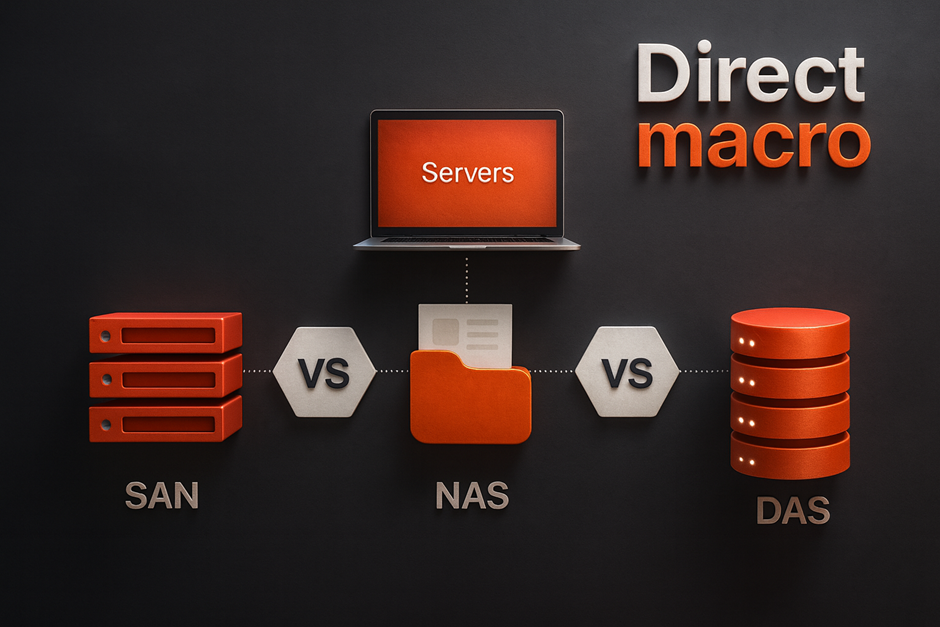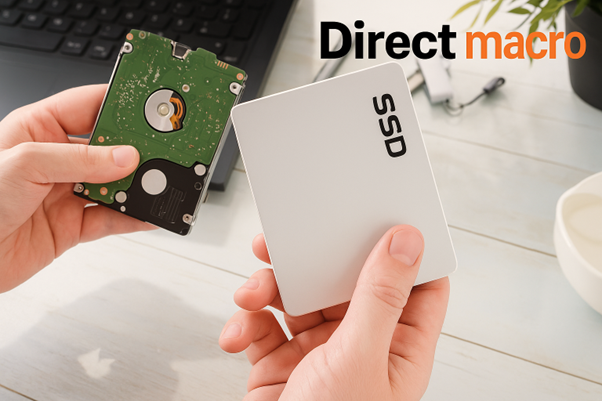How to Check SSD Health and Avoid Data Loss
Solid State Drives (SSDs) deliver incredible speed and durability, outperforming older hard drives in both speed and reliability, but they still wear out over time. Being smart about checking your SSD’s health can help you avoid data loss and maintain optimal performance.
Here is a detailed guide on how to check SSD health and prevent data loss. Regularly monitor your SSD’s status using built-in tools like Command Prompt or the Disk Management feature in Windows. You can also use third-party software and download a free tool like CrystalDiskInfo. Either way, these tools will give you a quick look at how your SSD is doing. Always back up your data and critical files frequently to prevent data loss. If the health report indicates signs of failure and wear, such as a high percentage of wear or an alert about uncorrectable sectors, replacing the SSD is a good option.
What Are the Warning Signs of SSD Failure?
Your SSD is about to dead if you noticed these warning signs.
- Bad Blocks Errors
If your SSD keeps marking bad sectors, the drive might be heading for total failure. Losing more sectors often means losing your data and system instability. - Slow Performance
If your computer starts dragging itself through boot times, application loading, or file transfers, it is the sign of SSD issues. - Error Prompts and Crashes
Unexpected error messages during accessing data, BSODs (Blue Screen of Death), and sudden restarts or system crashes usually point toward a failing SSD or a hard drive with serious issues. - SSD Not Being Detected or Showing Up as Read-Only
A severely failing SSD might not be recognized by the system or become inaccessible. - Corrupted Files or Folders
You may encounter issues opening files or find them inexplicably missing, so backups are your only safe bet.
How to Check SSD Health on Window 10 And Window 11?
You can check SSD health on Windows 10 and window 11 by following these steps.
1. Using Built-In Windows
- Check SMART Status via Command Prompt
Open Command Prompt as administrator and type wmic diskdrive get status. “OK” indicates no immediate issues.
- Use Window PowerShell
Open PowerShell as administrator and use the command Get-PhysicalDisk to check the health status of connected drives.
- View Drive Properties and Error Checking
Right-click on your SSD in File Explorer, go to “Properties,” then the “Tools” tab, and click “Check” under “Error Checking” to scan for errors.
- Performance Monitor Diagnostic
Search for and open Performance Monitor, navigate to Data Collector Sets > System > System Diagnostics, right-click and “Start” System Diagnostics. Review the report under Warnings for Disk Checks.
- Manage Disks and Volumes
Go to Settings > System > Storage > Advanced storage settings > Disks and volumes. Select your SSD and view its properties to see estimated remaining life and temperature.
- Run CHKDSK (Optional)
This tool, commonly used for HDDs, can also be run on SSDs to detect and attempt to fix bad sectors, although it might not always be the optimal method for SSDs.
-
- Open File Explorer, right-click on the SSD, go to Properties > Tools > Check under Error checking.
- In the Command Prompt, you can type chkdsk (drive letter) :/f to attempt to fix errors.
2. Using Built-In macOS
- Disk Utility (First Aid)
Go to Applications > Utilities > Disk Utility, select your SSD, and click First Aid to scan for errors.
- System Report
Click the Apple menu, About This Mac, then System Report, and Storage to check SSD type and status.
3. Using Built-In Linux
- Smartmontools
Install smartmontools (sudo apt-get install smartmontools on Debian-based systems) and use commands like sudo smartctl -H /dev/sdX (replace X with your drive letter) for a basic SMART test or sudo smartctl -a /dev/sdX for a detailed check.
- Disk Utility
On systems with GNOME, open Disk Utility, select your drive, and choose SMART Data and Self-Tests for detailed health information and to run self-tests.
Comparison Table
| OS | Built-in Tool(s) | Example Command/Step |
| Windows | CMD, PowerShell, Performance Monitor, Disks & Volumes | wmic diskdrive get status / Get-PhysicalDisk |
| macOS | Disk Utility, System Report | Run First Aid / About This Mac > Storage |
| Linux | smartmontools, GNOME Disk Utility | sudo smartctl -H /dev/sdX |
What Is the Best Software to Monitor SSD Health?
You can pick a third-party software to monitor the health and performance of your SSD. These advanced tools help you to analyse the performance and reliability of drives. They lay out SMART stats, error logs, and performance metrics. If a glitch looks ready to pounce, these apps wave a flag before you even notice. That way, you can fix a problem or back things up before drive failure, and detailed visualizations of drive health data make it a go-to tool for professionals, gamers, and small and medium businesses.
Here is some third-party software to monitor your SSD health.
- CrystalDiskInfo
This tool provides you an in-depth information about your SSD’s health, temperature, firmware version, current read/write speeds, and S.M.A.R.T. data. - Hard Disk Sentinel (HD Sentinel)
Monitors your drive continuously, performs real-time health checks, and generates reports with potential fixes to improve your SSDs health. - Disk Genius
This is free and user-friendly tool, this software lets you read S.M.A.R.T. data, find and fix bad sectors, and manage partitions from one dashboard. - EaseUS Partition Master
Includes a Disk Health feature for checking S.M.A.R.T. indicators, drive temperature, and health attributes in a single click. - Manufacturer-Specific Tools
Many SSD manufacturers offer dedicated tools for monitoring their drives, tools like Samsung, Magician, Kingston SSD Manager, Intel SSD Toolbox, and Crucial Storage Executive are finetuned to provide the most accurate data for the respective brands. - Other Tools
Consider utilities like SSD Life or Smartmontools for specialized monitoring and troubleshooting.
Regularly checking the health and performance of your SSD ensures that your data remains safe and your system runs smoothly. Whether you use built-in Windows tools or third-party software, these methods provide a comprehensive overview of your SSD’s condition. Stay proactive and keep your SSD in top shape.
How to Back Up SSD Data to Prevent Data Loss?
You simply follow these instructions to back up your SSD to prevent data loss.
- External Hard Drives
Copy important files or utilize features like Windows File History or backup software such as EaseUS Todo Backup to create regular backups of your SSD.
- Cloud Storage
Synchronize and store files on cloud services like OneDrive, Dropbox or Google Drive for off-site backup and accessibility.
- Backup Software
Create image backups or incremental backups using tools like EaseUS Todo Backup or Macrium Reflect. It depending on the type of backup requirements.
Backup Options Comparison
| Backup Method | Cost | Accessibility | Best For |
| External Drive | One-time | Local only | Large files, quick restore |
| Cloud Storage | Subscription | Anywhere | Daily work files, cross-device access |
| Backup Software | Free / Paid | Local + Cloud | Full system images, advanced users |
How to Improve SSD Performance and Extend Its Lifespan?
To extend the lifespan and improve its health and performance of your SSD, need to consider these steps.
- Enable TRIM
Running TRIM allows your SSD to clean up deleted files in the background, keeping it speedy without extra effort and improving performance. - Avoid Overfilling
Keep at least 20–30% of the total storage free on your SSD. It gives the SSD room to juggle files and prevents slowdowns. - Disable Hibernation
This feature writes large amounts of data to the SSD, which can impact its lifespan. Consider turning it off if you are not actively using it. - Update Firmware
Regularly update the SSD’s firmware. It ensures optimal performance and extends the life of your drive. - Optimize Power Management
Adjust Windows power settings to avoid frequent power cycles to manage system power efficiently. Fewer spin-up times mean less wear and calmer operation. - Consider SSD Specific Features
Many SSDs use extra tricks like overprovisioning and garbage collection. Letting the drive manage these helps it stay healthy. - Manage Heat
Ensure proper airflow to the SSD to prevent high operating temperatures from degrading NAND cells and reducing the SSD’s lifespan. - Check Partition Alignment
An aligned partition lets your SSD work efficiently, meaning less extra work and better speed. Use disk tools to check and fix alignment. - Disable Unnecessary Writes
Features like Windows search Indexing can add wear. If you don’t need them, turning them off saves your drive from extra write cycles.
Putting these steps in place boosts your SSD’s speed, extends its lifespan, and keeps your important files safe, reducing the chances of sudden data loss.
Tips to Avoid SSD Data Loss
These tips help you prevent data loss and protect important files.
- Regular Backups
To avoid SSD data loss, the first thing you need to consider is backing up your data regularly to an external drive, cloud storage, or another SSD.
- Monitor SSD Health
Regularly check your SSD’s health using the software and methods mentioned above.
- Consider Over-Provisioning
Some SSDs allow for over-provisioning, which can improve performance and lifespan. Considering this option helps you prevent data loss in the future.
- Firmware Updates
Regularly update your SSD’s firmware, as updates can sometimes improve performance and stability.
- Avoid Extreme Temperatures
Keep your computer in a well-ventilated area to avoid extreme temperatures. It can negatively impact SSD lifespan.
What to Do If Your SSD Fails? (Best Data Recovery Options)
If your SSD fails, consider these steps:
- Stop Using the SSD Immediately
When you notice any issue, stop using your SSD immediately. Further use can worsen the situation. - Try Connecting to Another Computer or Port
Rule out connection issues and try to connect your SSD to another computer or port. - Use Data Recovery Software (For Logical Failures)
If the SSD is still recognized, use tools like EaseUS Data Recovery Wizard or Wondershare Recoverit. These tools can help you recover lost data. - Consult Professional Data Recovery Services (For Physical Failures)
If the SSD is not detected or physically damaged, professionals such as Direct Macro can help you recover data. Call us at (855) 483-7810 for more information and support.
Important Note: The effectiveness of data recovery, particularly from SSDs, can be limited due to the way they manage data deletion and the TRIM function. Always prioritize regular backups to safeguard your valuable data.
Final Thoughts
Maintaining your SSD’s health isn’t difficult, it just takes consistency. By following these best practices and using available tools, you can extend the life of your drive, boost system performance, and protect your data from unexpected failure.
Looking For Reliable SSDs?
Explore Direct macro’s professional SSD lineup and discover durable, fast and reliable solutions for personal, creative, or professional use. call us at (855) 483-7810 for more information and support.
FAQs
-
How often should you replace an SSD?
Most SSDs (Solid State Disks) contain wear indicators which show how much longer they can be used. These count down from 100% of media life remaining down to 0%. An SSD should be replaced once its media life remaining is less than 10%.
-
How to check SSD health 2025?
To check SSD health Press Win + I to open Settings. Navigate to System > Storage > Advanced storage settings > Disks and volumes. Select your SSD and click on Properties. Here, you can view the drive health, including estimated remaining life and temperature.
-
Which SSD has longer life?
Single-level cell SSDs (SLC) have a particularly long life, although they can only store 1 bit per memory cell. They can withstand up to 100,000 write cycles per cell and are particularly fast, durable and fail-safe. Multi-level cell SSDs (MLC) have a higher storage density and can store 2 bits per flash cell.
-
How do you know the lifespan of an SSD?
In the IT industry, the lifespan of an SSD is in TBW. Mostly the service life of an SSD is 256 TBW. This is the basic warranty period after which the memory cells start degrading. The chances of drive failure and data loss increase after exceeding the TBW value.
-
How to check SSD TBW?
To check an SSD’s Terabytes Written and overall health, you can use CrystalDiskInfo tool, a free utility that accesses SMART data. Alternatively, you can use Windows PowerShell commands or the SanDisk Dashboard for Sandisk SSDs. The Total Host Writes value in CrystalDiskInfo or the Data Units Written in the SanDisk Dashboard indicates the TBW.
-
Is 1200 TBW good?
A TBW of 600-1200 TB is more appropriate for those who regularly edit photos or 1080p/4K videos. Professionals who work with 4K, 8K, or RAW files daily should look for M. 2 SSDs with a TBW of 1200 TB or more.
Do you need advice on buying or selling hardware? Fill out the form and we will return.

Sales & Support
(855) 483-7810
We respond within 48 hours on all weekdays
Opening hours
Monday to thursday: 08.30-16.30
Friday: 08.30-15.30







